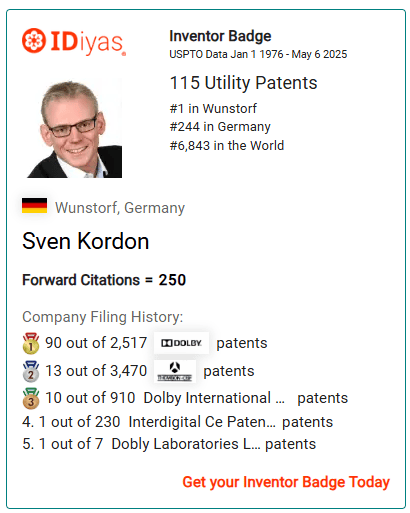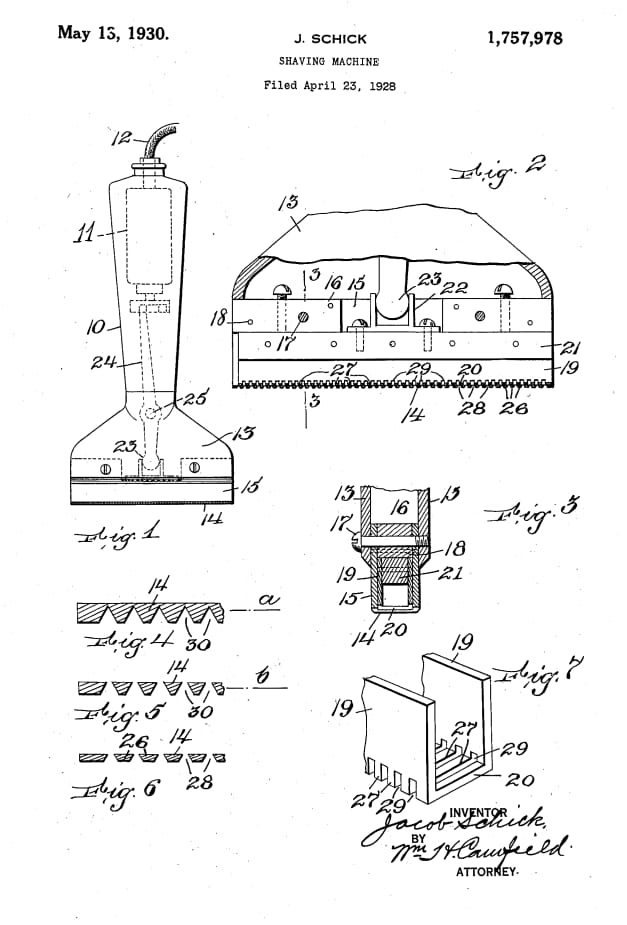
For the Inventor. By the Inventor.
See this week's breakthrough USPTO patent grants!
Interested in sponsoring this newsletter: Learn more here
New to IDiyas? Join 39,400 intellectually curious readers Subscribe Here!
Science Stories You Can’t Get Anywhere Else
Feed your curiosity with Nautilus — a science newsletter for thinkers, seekers, and the endlessly curious. Each week, we bring you beautifully written stories at the intersection of science, philosophy, and culture. From the physics of time to the psychology of awe, our essays, interviews, and ideas dive beneath the surface and linger in the mind.
Join a global community of readers who believe that big questions deserve thoughtful answers. Whether you're a lifelong learner or just love a good mystery of the universe, Nautilus will challenge how you see the world — and maybe even yourself.
Sign up now and start thinking deeper.
Table of Contents
This Week's Patent News:
National Inventors Hall of Fame Induction – At the ceremony on May 11, 2025, Commerce Secretary Lutnick expressed strong support for inventors, stating that they now have an advocate within the U.S. Patent Office.
GAO Criticizes USPTO Oversight – A report released on May 8, 2025, found that the USPTO’s efforts to improve patent examination are hindered by poor planning and inadequate oversight.
Patent Dispute Over AI-Generated Content – A federal judge ruled on May 8, 2025, that AI-generated content cannot be patented under current U.S. law, setting a precedent for future intellectual property cases involving artificial intelligence.
Amazon’s Crackdown on Counterfeiters – On May 7, 2025, Amazon intensified its legal actions against counterfeiters, filing multiple lawsuits in collaboration with intellectual property owners to combat unauthorized replicas of popular products.
Ninth Circuit Decision on Patent Royalties – On May 9, 2025, the Ninth Circuit reinforced the Brulotte rule against post-expiration patent royalties, clarifying that courts should assess such cases strictly as legal matters rather than based on negotiation history.
From Soot to Smiles: The Surprising Origins of Play-Doh
How a Forgotten Wallpaper Cleaner Became Every Child’s Favorite Toy
Play-Doh, the squishy, colorful staple of childhood creativity, began its life not in children's hands but in the grimy walls of post-war America. In the 1930s, a soap company called Kutol Products was on the brink of bankruptcy when it developed a nontoxic wallpaper cleaner, a doughy compound meant to remove soot from coal-heated homes. Its creator, Noah McVicker, likely never envisioned children molding it into dinosaurs instead of scrubbing soot-stained walls.

Fast-forward to the 1950s, when the invention's fortunes took a whimsical turn. As coal heating gave way to gas and electricity, the wallpaper cleaner faced obsolescence. Enter Kay Zufall, a nursery school teacher and the sister-in-law of Noah’s nephew, Joseph McVicker. Zufall noticed kids loved playing with the cleaner during arts and crafts and suggested repurposing it as a modeling compound. After some rebranding, some added colors, and voila, Play-Doh was born.
Joseph and Noah McVicker launched it in 1956 under the Rainbow Crafts Company. Play-Doh hit toy shelves with gusto, eventually catching the attention of toy giant Hasbro, which acquired the brand in 1991. By then, over 700 million pounds of Play-Doh had been sold, enough to sculpt an empire.
What began as a mundane cleaner became an iconic toy, proving that innovation isn’t just about invention; its about seeing potential where others see utility. And let’s face it, turning wallpaper grime into endless hours of childhood joy is nothing short of genius.
Trivia
How many Inventors since 1976 have all three types of Patents?
Please scroll to the bottom of this newsletter to find out.
Featured Inventor
The Sonic Architect: How Sven Kordon Quietly Shaped the Future of Digital Audio
Sven Kordon, a native of Wunstorf, Germany, stands as a luminary in the realm of digital audio engineering, boasting over two decades of pioneering contributions to the field. His extensive portfolio includes 115 issued patents, underscoring a career marked by innovation and technical excellence.
Kordon's expertise encompasses a broad spectrum of audio technologies, including digital signal processing, audio compression, 3D audio, and the transmission of audio and video over IP networks. His proficiency in programming languages such as C/C++, Python, and MATLAB has been instrumental in developing advanced audio solutions.

One of Kordon's notable achievements is his work on capturing and compressing sound fields using the Ambisonics representation, a full-sphere surround sound format. His contributions have significantly advanced the capture and compression of three-dimensional sound fields, enhancing the realism and immersion of audio experiences, and have been standardized in the well-known MPEG-H 3D Audio standard.
Throughout his career, Kordon has demonstrated a remarkable ability to shepherd projects from initial research through to final implementation and customer engagement. His work has not only pushed the boundaries of audio technology but has also had a tangible impact on the ways in which sound is experienced in various applications, from consumer electronics to professional audio systems.
Kordon's dedication to advancing audio technology continues to influence the industry, reflecting a blend of deep theoretical knowledge, practical implementation skills, and effective communication. His contributions have left an indelible mark on the field, setting a high standard for innovation and excellence in digital audio engineering.
Today in Patent History
On May 13, 1930, Colonel Jacob Schick was granted a patent for his innovative dry electric shaver, a significant advancement that revolutionized personal grooming by eliminating the need for water, soap, or shaving cream.
Jacob Schick's inspiration for the electric razor emerged during his time in Alaska and British Columbia in the early 1910s. While recuperating from an injury sustained during gold exploration, he found traditional shaving methods cumbersome in the harsh, cold environments. This led him to conceptualize a shaving device powered by an external motor connected via a flexible cable. However, this initial design was bulky and met with rejection from manufacturers.

U.S. Patent No. 1,757,978
Schick's military career, which included service during the Spanish-American War and World War I, provided him with experiences that influenced his inventions. Drawing inspiration from military equipment, he developed the Magazine Repeating Razor in 1921, which utilized a mechanism similar to a repeating rifle to load blades. This innovation allowed users to change blades without direct contact, enhancing safety and convenience. The success of this product provided Schick with the capital to further develop his electric razor concept.
By 1927, Schick had refined his electric razor design to be more compact and user-friendly. In 1928, he sold his interests in the Magazine Repeating Razor Company to focus entirely on his electric shaver. He founded Schick Dry Shaver, Inc., and began marketing his product. Despite launching during the onset of the Great Depression, the electric shaver gained popularity for its convenience. By 1937, over 1.5 million units had been sold.
Jacob Schick's invention paved the way for modern electric shaving devices, influencing subsequent designs and leading to the widespread adoption of electric razors. His contributions significantly impacted the personal grooming industry, offering a convenient alternative to traditional wet shaving methods.
For a visual overview of this historical milestone, you might find the following video informative:
Introducing New Data Products and Enhancements
How to find new inventors who have received fewer than 10 patents in the last two years? Here are the new filters available on the 'Top Inventors' page.

Our Premium members on average have 312 patents.
IDiyas is the world’s largest resource for celebrating and supporting inventors. Become a member of the IDiyas Inventor Membership Program to foster the community of innovation – locally and globally. Access millions of inventors and patents, and connect through networking and engaging events. Join today to enjoy exclusive benefits with our limited-time membership offer.

Centurion Patentors
Congratulations to last week's Centurion Patentors!
We are excited to welcome the following inventors into these prestigious patent clubs:

For more info about their research & patents, click here
Trivia
The answer is: 38 (since 1976), for more details, click here
Recommendations

Sponsored
MaxDividends
High Yield & Dividend Growth Stocks worth Investing In to Boost Your Passive Income for Living Off Dividends and Retire Early. Top Secret Stuff is Going Inside. 100,000+ constant readers!

Sponsored
Money Masters
Money Masters Is Your Source For Money News.

Sponsored
Smart Money
What are the world’s top investors and hedge funds buying? We track elite portfolios and turn public filings into smart, simple stock ideas you can use. Think of us as your shortcut to institutiona...
Fact-based news without bias awaits. Make 1440 your choice today.
Overwhelmed by biased news? Cut through the clutter and get straight facts with your daily 1440 digest. From politics to sports, join millions who start their day informed.



